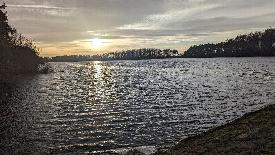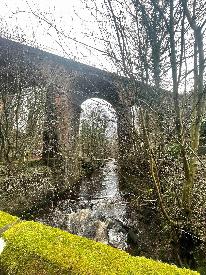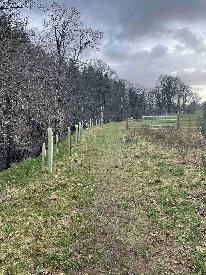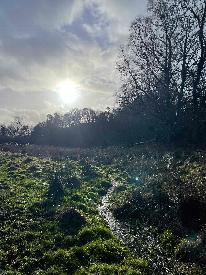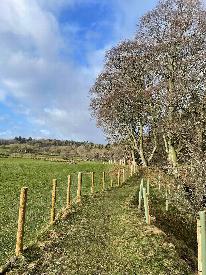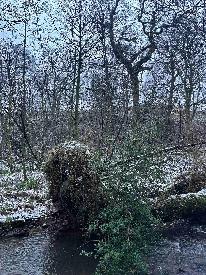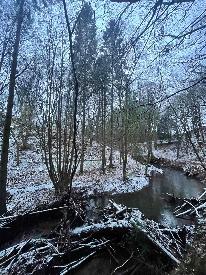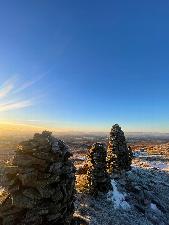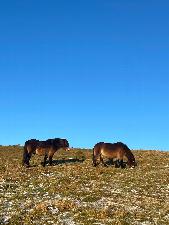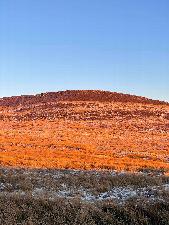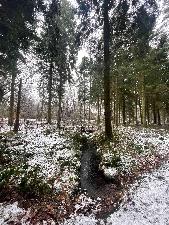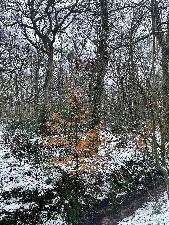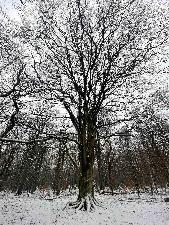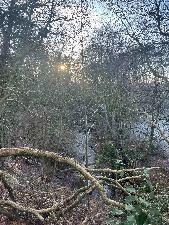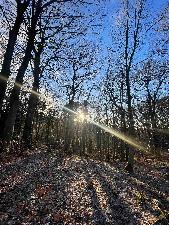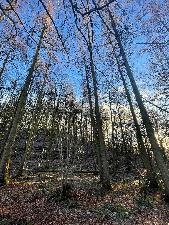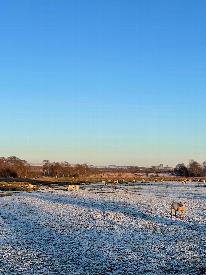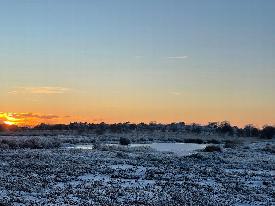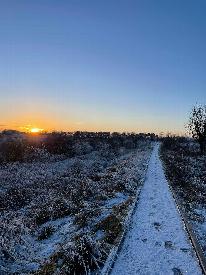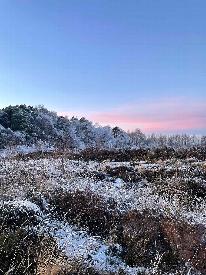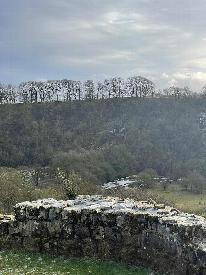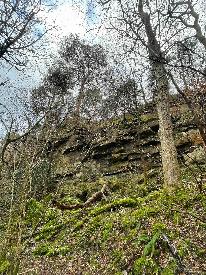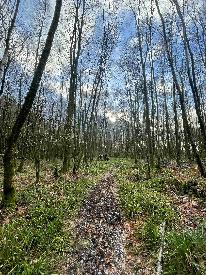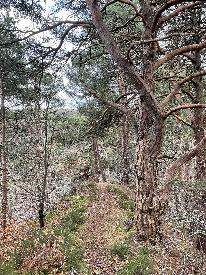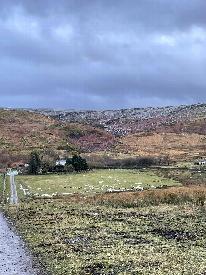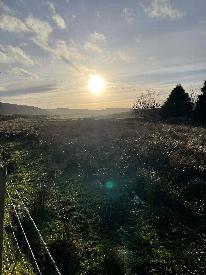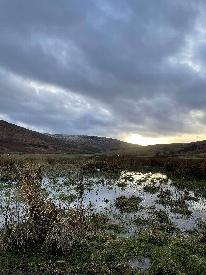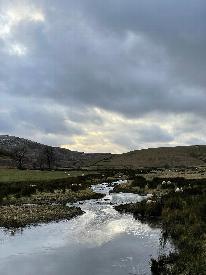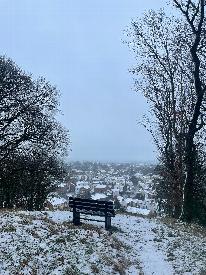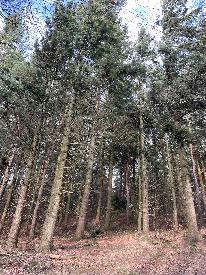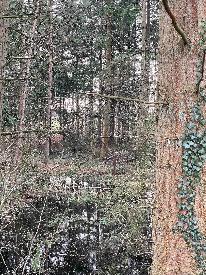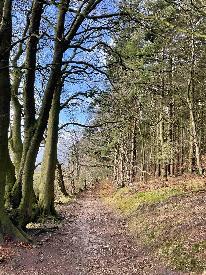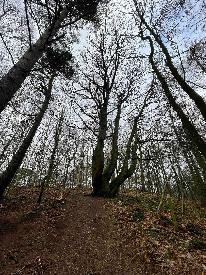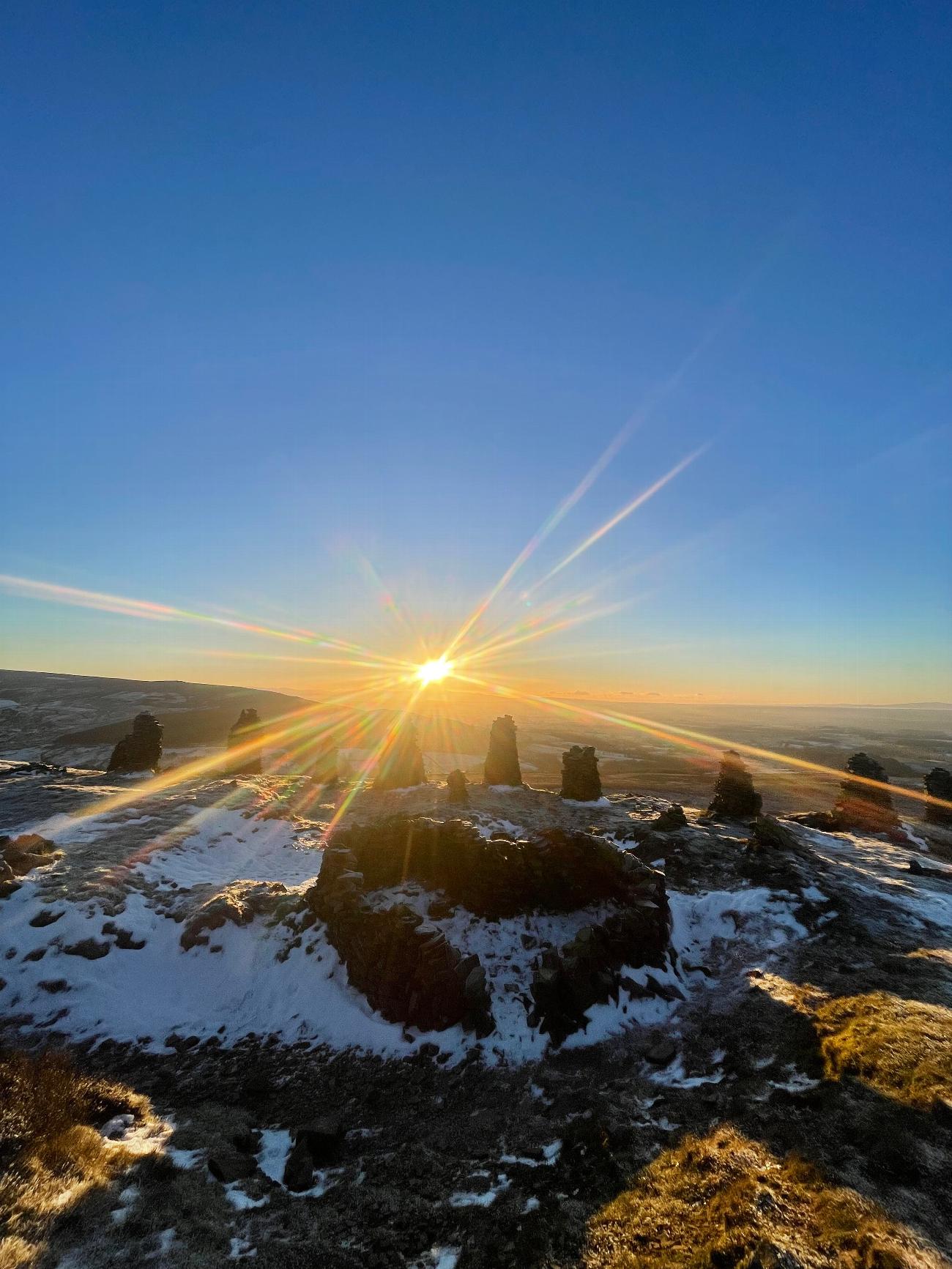
View from summit of Talkin Fell
Photos credited to Josh Kennedy
Middle Gelt and Greenwell
Greenwell walks/ River Gelt
Why cannot nature look after itself?
Two interventions here: Erecting a fence to stop farm stock from getting to the river, polluting the water and eating all the wild flowers and planting trees to stop river bank erosion.
This picturesque natural stream could provide greater value for nature if we were to hold back some of the water-flow creating a leaky dam. This would transform the area into a Wetland providing vital benefits, such as a biodiversity hotspot, improving water quality, mitigating floods, and sequestering carbon.
Future
In a few years this bank will be populated with more wild flowers and the water quality will be better.
Quarry Beck Woods
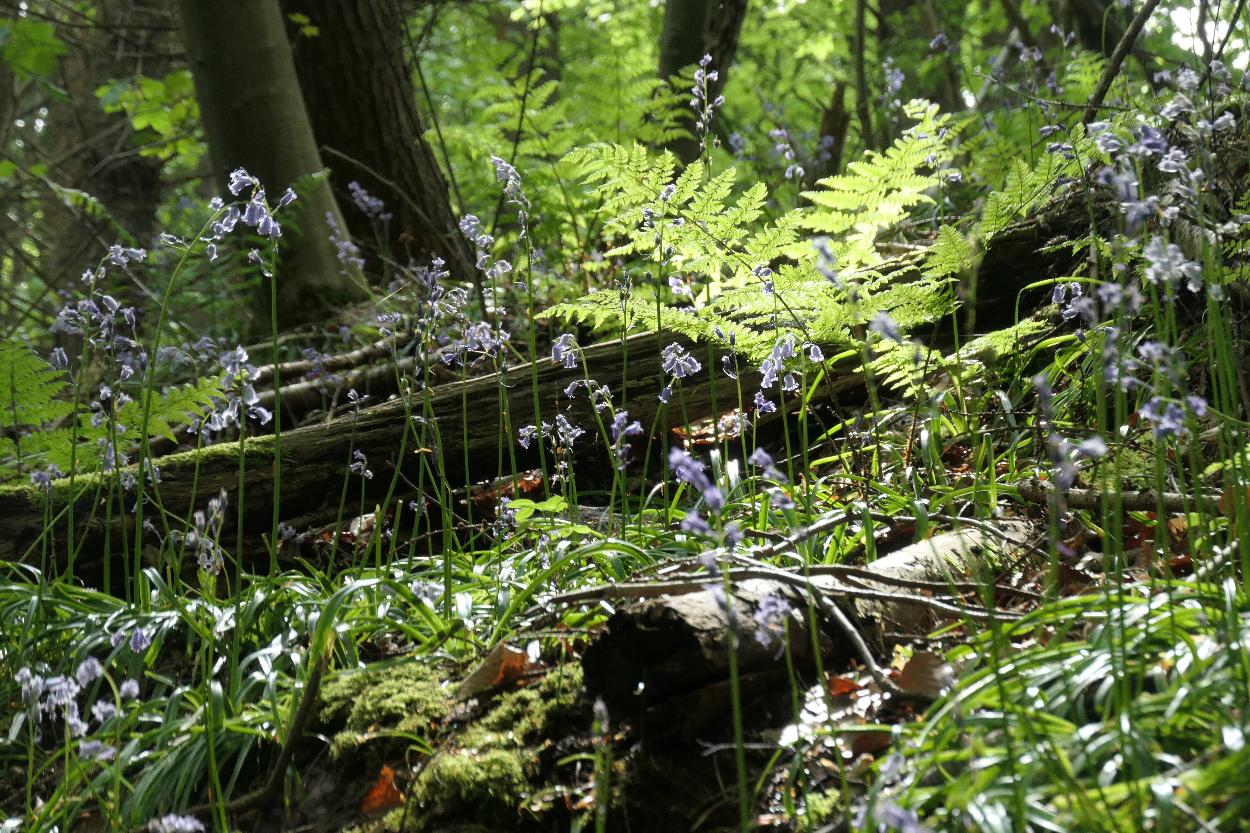
Bluebells are indicators of ancient woodlands; they contribute to preserving mature ecosystems. Their vibrant flowers provide nectar for pollinators, supporting insect populations. Bluebell-rich habitats serve as essential breeding and foraging grounds for numerous species, enhancing overall biodiversity. Conservation efforts to protect bluebells also benefit the broader ecosystem, promoting the health and resilience of woodlands. Photo David Dixon
While dead wood might seem lifeless, it's not. in fact, regeneration is at work. playing a vital role in sustaining the intricate web of life within woodlands. Conservation practices often emphasize the importance of leaving dead wood in situ to preserve the ecological balance and promote biodiversity.
The bluebells in May can be quite spectacular. Photo David Dixon
Look the Beavers have been busy at work! While we all wish this was in fact true its just natural build-up of debris… Oh Dam.
Talkin Fell
View from the summit
Simply sit back and enjoy the view, the benefits of nature on wellbeing are diverse and encompass stress reduction, improved mood, increased creativity, better sleep, enhanced focus, reduced mental fatigue, improved emotional well-being, and a sense of connection to the natural world. Incorporating nature into daily life can have lasting positive effects on mental health. So, get yourself out in nature as often as possible.
Grazing animals,
like horses, benefit nature by promoting biodiversity, maintaining open landscapes, aiding in seed dispersal, enhancing soil health, controlling erosion, and attracting wildlife. Their presence creates a dynamic and balanced ecosystem, fostering a connection between humans and nature.
Peatlands
hold significant value due to their biodiversity support, carbon sequestration, water regulation, flood prevention, and provide a habitat for rare species. Peatlands hold a vital role in global climate change mitigation. Conservation and sustainable management are crucial to preserve the diverse benefits provided by these ecosystems.
Miltonrigg Wood (Woodland Trust)
Drainage?
Draining woodlands is controversial because it can have significant negative impacts on the ecosystem. Draining alters the natural hydrology of the area, leading to soil erosion, loss of habitat, and disruption of water-dependent flora and fauna. Wetland ecosystems are particularly vulnerable to drainage, and their destruction can result in the loss of biodiversity, increased flood risk, and diminished water quality. Additionally, drained woodlands may be less resilient to climate change which can contribute to the decline of species dependent on moist environments.
Natural regeneration
Natural regeneration of trees can be seen, this suggests a self-sustaining and resilient ecosystem where trees reproduce and regenerate on their own accord. Natural regeneration is often indicative of a healthy and biodiverse environment, as it allows for the establishment of a diverse range of tree species and supports the overall ecological balance.
Ancient Trees
Ancient trees, having endured for centuries, are biodiversity hotspots, providing unique habitats for various species. These resilient giants offer ecosystem services, playing vital roles in oxygen production, carbon sequestration, and soil stabilization. Preserving ancient trees is crucial for conservation, education, and research, offering insights into ecological processes and the impacts of human activities over time. Recognising their importance ensures the continued beauty, biodiversity, and sustainability of our natural and cultural landscapes.
Gelt Woods (RSPB reserve)
The wood home to a diverse range of trees, lovely beech, oak and elder wood. This mix of trees are vital for supporting biodiversity by maintaining ecosystem stability helping to adapt to climate change by preserving soil health and increasing resistance to diseases while sequestering carbon effectively. The river runs down from North Pennines (Jockey Shield) and has a thick peaty colour to the water. Often you will see Heron and duck here. offering a peaceful and relaxing walk through stunning local wildlife.
View from near Lower Gelt Bridge
The river has cut a gorge through the sandstone
Masts for tall ships
Apparently, at one time these tall straight oaks were used for ship building.
Woodland regeneration
The woods are owned by Brampton Parish Council who are allowing the woodland to regenerate naturally
Walton and Bolton Moss (Natural England Reserve and SSSI
Surrounded by farmland the raised peat bog used to employ over 70 people digging up peat to heat homes and for agriculture.
Peat moss, especially sphagnum moss, is ecologically important, It plays a major role in carbon storage, water regulation, creation of acidic conditions leading to the formation of more peat and the preservation of carbon over time. Furthermore, biodiversity support, and habitat for microorganisms. Protecting and restoring peatlands, where peat moss thrives, are crucial for sustaining these ecological functions and overall ecosystem well-being.
The peat moss must not be left to "dry out"
Discover the wonders of the ‘moss of many layers', as you walk the accessible 3km boardwalk, this rare and unique habitat is home to flora and fauna, re-claiming their place within a naturally restorative process.
Regeneration
of woodland must not be allowed as the trees suck up the water. If the moss is "healthy" then the peat is too acidic for the trees to grow.
Gilsland: Birdoswald walk/ Comb Crag
This view from Hadrian's Wall at Birdoswald shows the bank of trees which stop subsidence and provides a biodiverse habitat for animals and insects.
Comb Crag
Comb Crag has special significance for its geological, historical and biodiverse interest. There is much moss and lichen which are great carbon sequestrates and provide habitats for slugs which birds enjoy. Comb Crag is the site of an old Roman Quarry with rich damp soil promoting growth of mossy banks creating a home for many creatures. These are mainly invertebrates and include species like woodlice and slugs. Moss is constantly ‘on the move' as the blackbirds tug it up looking for a tasty meal underneath. Moss is also home to a host of microscopic invertebrates such as rotifers, tardigrades and nematodes.
Blue bells
One route to Comb Crag is from the Hadrian's Wall Footpath. In spring the bluebells are very special.
This is a lovely walk for those who enjoy water, a few steep climbs, exploring muddy paths with a rich blend of plants and trees.
Comb Crag outcrop
An intrusion of very hard igneous rock forms this outcrop where the footpath goes down to the river. The written rock is near here and is well worth discovering. Here is a link to some music and poetry. LINK
Tindale Tarn & RSPB Geltsdale
Wetlands are biodiversity hotspots, supporting diverse plant and animal life. Essential for waterfowl, amphibians, and insects, they serve as breeding and feeding grounds. Wetlands play a crucial role in flood prevention, water purification, and carbon storage, making them vital for ecological balance and climate change mitigation. Preserving these habitats is essential for safeguarding biodiversity and maintaining a healthy environment.
Heather moorland can also be seen on the distant Cold Fell. This provides critical ecosystems for a variety of plant and animal species. Iconic wildlife such as red grouse, mountain hares, and curlews thrive in this environment. Moreover, heather moorlands play a role in carbon storage and water regulatio
has many different habitats which are attracting a variety of birds.
.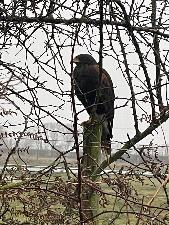 A mighty Bird of Prey, this indicates a high level of biodiversity with plenty food resources. Do you know what type of Bird this is?
A mighty Bird of Prey, this indicates a high level of biodiversity with plenty food resources. Do you know what type of Bird this is?
Part of the Natural Flood Management scheme is to provide a space for storing the water.
Experts believe this work will create the ideal habitat for snipe and other bird species including curlew, black grouse, lapwing and redshank.
The new habitat created will be valuable for the wading birds on the reserve, and the plant and animal communities that support them.
Natural bends were added to Howgill Beck, in Geltsdale, to return it to its natural design and create a habitat for bird species, It now curves through the land and can spill on to a floodplain when required.
Brampton Walks
Ridgewood (Woodland Trust) ..... to be added later
Dandy Woods
Although this may look a healthy woodland in fact it could be considered a ‘Dead Wood' as a result of Lack of biodiversity in the wood which can lead to ecological imbalances and increased vulnerability to diseases. Moreover, a loss of crucial ecosystem services, decreased adaptability to environmental changes, disrupted nutrient cycling, loss of genetic diversity, impacting negatively on wildlife. Addressing this issue requires conservation efforts, reforestation with diverse native species, and sustainable land management practices to restore ecological balance and preserve the multitude of benefits that biodiverse woodlands provide.
Ponds
Ponds are biodiversity hotspots, fostering a rich variety of life. From amphibians using them as crucial breeding grounds to insects, birds, and mammals finding habitat and sustenance, ponds contribute significantly to ecosystem diversity. Aquatic plants enhance water quality, while ponds attract pollinators, further enriching the surrounding landscape. The educational and conservation value of ponds is immense, offering opportunities for observation, study, and protection of species that rely on these aquatic ecosystems. Preserving and managing ponds is vital for sustaining biodiversity and fostering a connection between people and nature.
Path to the ancient tree past a row of mature beech trees.
Ancient trees, having endured for centuries provide unique habitats for various species. These resilient giants offer ecosystem services, playing vital roles in oxygen production, carbon sequestration. Recognising their importance ensures the continued beauty, biodiversity, and sustainability of our natural and cultural landscapes.
Get involved with our community net carbon zero projects!
Contact us here through
